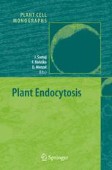Search
Search Results
-
Plant Vacuoles: from Biogenesis to Function
The plant vacuolar system is far more complex than originally expected and multiple sorting pathways leading to various types of vacuoles can be...
-
Endocytosis in Guard Cells
Stomatal movement requires large and repetitive changes to cell volume and consequently surface area. These alterations in surface area are...
-
Endocytosis and Actomyosin Cytoskeleton
Mutual interactions between actin and endocytic assembly machineries are essential for successful clathrin-mediated endocytosis in yeast and...
-
Endocytosis and Membrane Recycling in Pollen Tubes
In plants, tip-growing cells are an ideal system to investigate signal transduction mechanisms and, among these, pollen tubes are one of the...
-
Comparative Analysis of Biological Models used in the Study of Pollen Tube Growth
The mechanisms of pollen tube growth have been studied in a wide variety of plant species. Since the 1990s, with the explosion of molecular...
-
Plant Prevacuolar Compartments and Endocytosis
Prevacuolar compartments (PVCs) are membrane-bound organelles mediating protein traffic from both Golgi and plasma membrane to vacuoles in...
-
Importance of Cytoskeleton and Cell Wall in Somatic Embryogenesis
Both the cytoskeleton composed of microtubules and actin microfilaments as well as cell wall components such as arabinogalactan proteins and...
-
Ions and Pollen Tube Growth
Ions play a crucial role in the control of pollen tube growth. In this review we focus on four that seem especially important: calcium (Ca...
-
Gametic Embryogenesis in Triticum: a Study of Some Critical Factors in Haploid (Microspore) Embryogenesis
This review of embryogenesis from microspores in two types of wheat examines the influences of various procedures used to induce and produce...
-
The Roles of Chromatin Remodelling Factors in Replication
Dynamic changes of chromatin structure control DNA-dependent events, including DNA replication. Along with DNA, chromatin organization must be...
-
The Generation and Recognition of Histone Methylation
The posttranslational modification of histone proteins via methylation has important functions in gene activation, transcriptional silencing,...
-
Structure and Function of Protein Modules in Chromatin Biology
Chromatin-mediated gene transcription or silencing is a dynamic process in which binding of various proteins or protein complexes can displace...
-
Histone Dynamics During Transcription: Exchange of H2A/H2B Dimers and H3/H4 Tetramers During Pol II Elongation
Chromatin within eukaryotic cell nuclei accommodates many complex activities that require at least partial disassembly and reassembly of...
-
Mouse Models of Cell Cycle Regulators: New Paradigms
In yeast, a single cyclin-dependent kinase (Cdk) is able to regulate diverse cell cycle transitions (S and M phases) by associating with multiple...
-
Folding of newly synthesised proteins in the endoplasmic reticulum
The endoplasmic reticulum (ER) is a membranous compartment that can be found within any nucleated eukaryotic cell. Its job is to oversee the...
-
Histone Ubiquitylation and the Regulation of Transcription
The small (76 amino acids) and highly conserved ubiquitin protein plays key roles in the physiology of eukaryotic cells. Protein ubiquitylation...
-
Conditional senescence in prokaryotes
Bacteria are immortal in the sense that their capacity for reproduction appears limitless as long as the environment supports growth. However, this...
-
Do green plants age, and if so, how?
Time-dependent ageing-like processes in green plants are discussed and compared to gerontological changes in animals and other organisms. The...
-
Introduction: Lipids: cellular glue...or are they more than that?
Some 40 years ago, there was a rumor in the research community that lipids are the stuff you have to throw away before starting biochemical...
-
10 Sphingosine-1-phosphate metabolism in mammalian cell signalling
Sphingosine-1-phosphate (S1P) is a bioactive sphingolipid metabolite implicated in the regulation of vital biological processes. Ample evidence...
